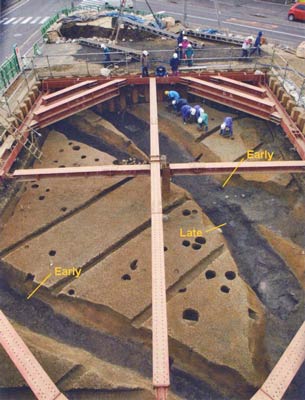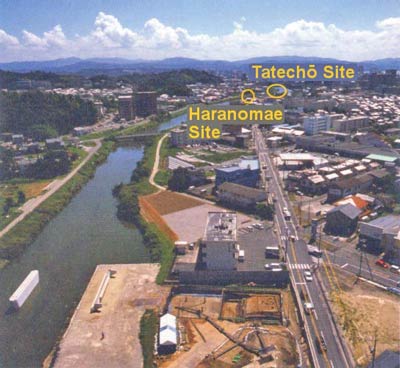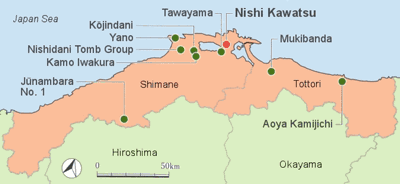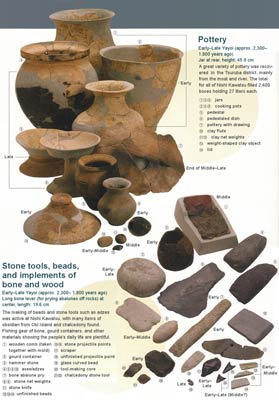Nishi Kawatsu:
Early and Late Yayoi moats are found. Clarification proceeds of a core
settlement of the San'in region.

Moats (from the north) Large-scale ditches from the Early and Late Yayoi periods were detected. The longest of these has been ascertained as running 30 m or more.
Adapted from Hakkutsu sareta Nihon rettō 2013 [Excavations in the Japanese Archipelago, 2013] (Bunkachō [Agency for Cultural Affairs], ed., Asahi Shimbun Publications, 2013).
|
 Central portion of the Nishi Kawatsu site (from the southeast) Tsuruba district is in the center of the photo, and to its right was the Kaizaki district, where the river now flows. The settlement is thought to have extended towards the upper left from the excavation area. Also, at the Sawashimo site (yellow arrow) atop a hill in the upper part of the photo, a group of mound-burials including items with four projecting corners has been ascertained.
Adapted from Hakkutsu sareta Nihon rettō 2013 [Excavations in the Japanese Archipelago, 2013] (Bunkachō [Agency for Cultural Affairs], ed., Asahi Shimbun Publications, 2013).
|
 Asakumi River Site Group (from the north) Tsuruba district is in the foreground. The site spreads over both sides of the Asakumi river (on the left of the photo), and together with the downstream sites of Haranomae and Tatechō, it is called the Asakumi River Site Group. Lake Shinji, in the background, has been receding to the south since the Late Jōmon period, and it is thought that settlements of the Yayoi period were built on small rises of land made by the action of the river.
Adapted from Hakkutsu sareta Nihon rettō 2013 [Excavations in the Japanese Archipelago, 2013] (Bunkachō [Agency for Cultural Affairs], ed., Asahi Shimbun Publications, 2013).
|
 Wooden agricultural tool (hoe) in situ From within the natural river course, in addition to large amounts of Yayoi pottery and stone tools, there were hoes, mud guards, axe handles and other agricultural tools recovered in large numbers. Nearly all are unfinished, and it is thought that tool making was carried out in the vicinity. |
 Locations of major Yayoi sites of the San'in region
Adapted from Hakkutsu sareta Nihon rettō 2013 [Excavations in the Japanese Archipelago, 2013] (Bunkachō [Agency for Cultural Affairs], ed., Asahi Shimbun Publications, 2013).
|

Adapted from Hakkutsu sareta Nihon rettō 2013 [Excavations in the Japanese Archipelago, 2013] (Bunkachō [Agency for Cultural Affairs], ed., Asahi Shimbun Publications, 2013).
|
Nishi Kawatsu Site, Matsue City, Shimane Prefecture
A core settlement from the Early to the Late periods
Nishi Kawatsu is a large-scale settlement site from the Early to Late Yayoi periods in the Asakumi river basin on the Shimane peninsula, at an elevation of 0 – 2 m above sea level. Between 1979 and 2011, excavations were conducted intermittently in the Kaizaki, Tsuruba, Miyao/Tsubouchi districts and elsewhere within the site.
In the Kaizaki district investigation, an occupation surface from the Early (about 2,200 years ago) and Middle Yayoi (2,000 years ago) periods was discovered, and features such as embedded pillar buildings, a facility for storing lumber, and shell middens, plus an enormous number of artifacts were recovered, featuring a variety of pottery brought from other regions, plus large amounts of wooden implements, shell bracelets, bronze bells, and so forth. The central portion of the settlement extended 0.2 km east-west by 0.4 km north-south. It has come to be regarded as an exemplary core settlement of the San'in region.
Discovery of a moat raises hopes for clarifying the residential area
In the Tsuruba district, where excavation was carried out from 2009 to 2011, large ditches of 2 –3 m width that were possibly moats of the Early and Late Yayoi (1,900 years ago) periods were detected, and large amounts of carbonized rice, and unfinished wooden implements and stone tools were discovered. Also, on the western side of Tsuruba district a natural river course about 10 m or greater in width has been found, and the possibility of this being the western edge of the settlement has increased.
In recent years, excavations have been conducted continuously at large-scale core settlements of the San'in region, such as Yano (in Izumo city, Shimane prefecture) and Historic Site Aoya Kamijichi (Tottori city, Tottori prefecture), and the image of the San'in region of the Yayoi period is gradually becoming clearer. (Higashimori Susumu)
(principal artifacts, Nishi Kawatsu Site)

